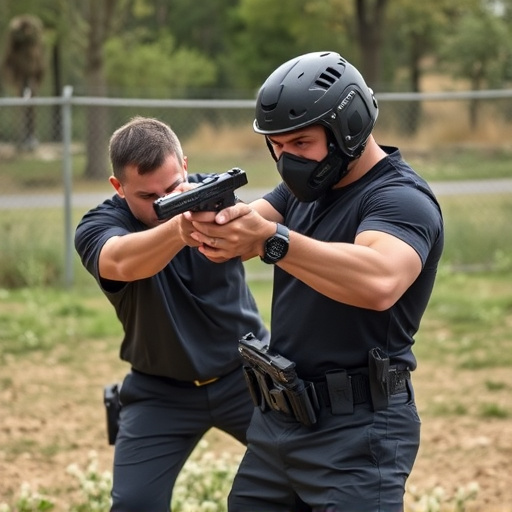Safety Switches: Ensuring Responsible Use of Stun Guns via Neuromuscular Understanding
The Neuromuscular Effects of Stun Devices stun guns by disrupting muscle cell electrical activity, c…….
The Neuromuscular Effects of Stun Devices stun guns by disrupting muscle cell electrical activity, causing temporary paralysis. This effect, achieved through high-voltage, low-current pulses, lasts from seconds to half a minute, depending on device power and target size. Safety switches in stun gun design prevent accidental activations, while best practices for activation and use—including inspections, controlled triggers, targeted strikes, and battery maintenance—ensure safe deployment without prolonging discomfort or causing harm. Understanding these Neuromuscular Effects is vital for responsible and effective use.
The neuromuscular disruption caused by stun devices makes them a powerful tool for self-defense. But understanding how they work, especially through the critical component of safety switches, is essential for responsible use. This article explores the science behind neuromuscular disruption and delves into the design and best practices surrounding stun gun activation switches, providing insights crucial for ensuring their safe and effective application.
- Understanding Neuromuscular Disruption: How Stun Guns Work
- Safety Switches: A Critical Component in Stun Gun Design
- Best Practices for Safe Activation and Use of Stun Devices
Understanding Neuromuscular Disruption: How Stun Guns Work

Stun guns, also known as electroshock weapons, operate by inducing neuromuscular disruption in their target. When activated, they emit a high-voltage, low-current electric pulse that interferes with the nervous system’s ability to send signals to muscles. This interference causes a temporary paralysis or shock, allowing the user time to escape or subdue an attacker.
The Neuromuscular Effects of Stun Devices are significant. The electric current disrupts the electrical activity in muscle cells, leading to a loss of control over voluntary muscles. This disruption can last from several seconds to up to half a minute, depending on the device’s power and the target’s size and resistance. It’s crucial to understand these effects to ensure safe and effective use, as proper activation requires precise timing and understanding of the technology’s limitations.
Safety Switches: A Critical Component in Stun Gun Design

Safety switches play a pivotal role in the design and functionality of stun guns, acting as a crucial component to ensure user safety and prevent accidental activations. These switches are strategically positioned within the device, providing an extra layer of protection against unintended use. When incorporated into stun gun mechanisms, they serve as a safeguard, particularly important given the powerful neuromuscular effects of stun devices.
The primary function of these switches is to interrupt the electrical circuit, effectively deactivating the stun gun when not in use or when certain conditions are met. This is especially critical considering the potential side effects of stun guns, which can include temporary muscle paralysis and disorientation. By incorporating safety switches, manufacturers aim to minimize risks associated with these devices, ensuring users can rely on them during self-defense scenarios while mitigating accidental harm.
Best Practices for Safe Activation and Use of Stun Devices

When activating and using a stun device, adhering to best practices is paramount for ensuring safety. Always conduct a thorough inspection before deployment; check for any signs of damage or malfunction, ensuring all components are in working order. The activation process should be deliberate and controlled; avoid rapid or aggressive triggers, as this can lead to accidental discharge or excessive neuromuscular effects of stun devices.
Proper use involves targeting specific body areas like the thighs, arms, or back, where nerve endings are concentrated. Aim for a firm, swift strike to deliver the required electrical shock without causing prolonged discomfort or injury. Regularly service and maintain your stun device, replacing batteries promptly and storing it in a secure, accessible location. Remember, responsible ownership includes staying informed about local laws and regulations regarding stun gun activation and use.
The neuromuscular disruption caused by stun devices, through their unique mechanism of action, provides a powerful personal safety tool. Incorporating a safety switch in their design is a critical step to ensure responsible use and mitigate potential risks. By following best practices outlined in this article for activation and use, individuals can leverage the benefits of stun guns while prioritizing their safety and the safety of others.


